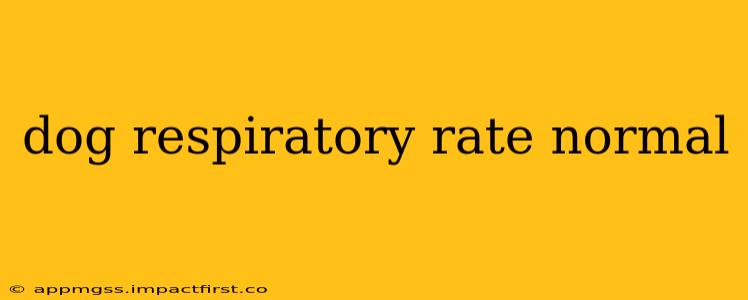Knowing your dog's normal respiratory rate is crucial for recognizing potential health problems. A change in breathing pattern can be an early warning sign of illness or distress. This guide provides a detailed explanation of how to measure your dog's respiratory rate, what's considered normal, and when you should seek veterinary attention.
What is a Normal Respiratory Rate for Dogs?
A dog's normal respiratory rate varies depending on factors like breed, age, size, and activity level. Generally, a healthy adult dog at rest will breathe between 10 and 30 breaths per minute. However, puppies and smaller breeds often breathe faster than larger, adult dogs. Exercise, excitement, and even stress can temporarily increase respiratory rate.
Important Note: This range is a guideline. Observing your dog's breathing pattern regularly will help you establish their baseline. Any significant deviation from this baseline warrants attention.
How to Measure Your Dog's Respiratory Rate
Accurately measuring your dog's respiratory rate involves a simple process:
- Find a quiet, comfortable spot: Your dog should be relaxed and resting. Avoid stressful situations that could elevate their breathing rate.
- Observe their chest or abdomen: Watch the rise and fall of their chest or abdomen. Each rise and fall constitutes one breath.
- Count the breaths for 15 seconds: Using a stopwatch or timer, count the number of breaths for 15 seconds.
- Multiply by four: Multiply the number of breaths counted in 15 seconds by four to obtain the breaths per minute.
For example, if you count 5 breaths in 15 seconds, their respiratory rate is approximately 20 breaths per minute (5 x 4 = 20).
What Factors Can Affect a Dog's Respiratory Rate?
Several factors can influence a dog's respiratory rate, impacting the reading you obtain. Understanding these factors can help interpret the results more accurately:
- Age: Puppies breathe faster than adult dogs.
- Breed: Smaller breeds generally have faster respiratory rates than larger breeds.
- Exercise: Physical activity significantly increases respiratory rate.
- Temperature: Hot weather or high temperatures can increase respiratory rate.
- Stress or Anxiety: Nervousness or fear can elevate breathing rate.
- Underlying Medical Conditions: Illness can cause changes in breathing patterns, such as increased or labored breathing.
What if My Dog's Respiratory Rate is Abnormally High or Low?
If your dog's respiratory rate falls outside the normal range or if you observe other unusual breathing patterns (e.g., labored breathing, gasping, wheezing, or blue-tinged gums), you should consult a veterinarian immediately. This could be a sign of a serious medical problem, including:
- Heart disease: Conditions such as heart failure can affect breathing.
- Lung disease: Pneumonia, bronchitis, or other lung conditions.
- Heatstroke: Overheating can cause rapid and labored breathing.
- Anaphylaxis: Severe allergic reactions can cause respiratory distress.
- Other systemic conditions: A variety of medical conditions can impact respiratory function.
How Often Should I Check My Dog's Breathing?
Regularly monitoring your dog's breathing, especially during periods of illness or stress, is essential. While daily checks aren't necessary for healthy dogs, it's beneficial to observe their breathing during routine interactions. This helps you establish a baseline and recognize any deviations from the norm promptly.
What are some other signs of respiratory problems in dogs?
Besides an abnormally high or low respiratory rate, other signs of respiratory distress in dogs include:
- Labored breathing: Visible effort in breathing, such as heaving chest or abdominal muscles.
- Wheezing or rattling sounds: Noisy breathing.
- Coughing or gagging: Persistent or unusual coughing.
- Cyanosis (blue gums): Blue discoloration of the gums, indicating insufficient oxygen.
- Open-mouthed breathing: Especially in brachycephalic (short-nosed) breeds.
This information is intended for educational purposes only and should not be considered a substitute for professional veterinary advice. Always consult your veterinarian if you have concerns about your dog's health. They can properly diagnose any underlying issues and recommend appropriate treatment.
